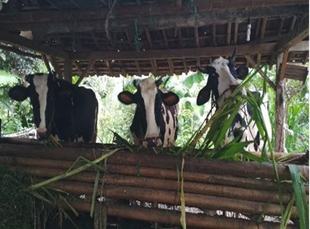Advocacy for quantitative progesterone assay in the breeding management of bitches

Downloads
Peripheral progesterone titers characterizing the reproductive cycle of the bitch are fairly well-documented in literature. Progesterone titers obtained via fluorescence-immunoassay technique at different points to the appearance-of-bloody-vulva-discharge (ABVD) in apparently healthy, exotic, multi-breed bitches (n = 76) that were subsequently inseminated were summarized using descriptive statistics. The recommended/predictable progesterone titer-ranges- PPTRs (ng/mL) and modality for insemination(s) were: 7.6-8.5 (inseminate-after-24-hours), 8.6-9.9 (inseminate-after-12-hours) and 10.0-20.0 (inseminate-immediately). The length of days from ABVD to the point of obtaining a PPTR (Mean ± SD) was 12.43 ± 3.38 days (range 8-17 days). The frequencies of progesterone assay per bitch were: one-fold (39.47%), two-fold (39.47%). three-fold (18.43%) and four-fold (2.63%). Observations on pregnancy statuses of bitches based on frequency of progesterone assay(s) were: 57.90% (pregnant, multiple-assay), 5.26% (pregnant, one-fold-assay), 26.32% (not-pregnant, multiple-assay) and 10.52% (not-pregnant, single-assay). The litter sizes at the PPTRs (Mean ± SD) i.e., 7.83 ± 1.86 (7.6-8.5 ng/mL), 7.86 ± 1.73 (8.6-9.9 ng/mL) and 8.83 ± 1.86 (10.0-20.0 ng/mL) were comparable with that for the entire study i.e., 8.16 ± 1.87. Similarly, the range of litter sizes at the three PPTRs as well as that for the entire study were same i.e., 5-10 puppies. It is concluded as follows: multiple progesterone assays resulted in higher pregnancy outcome and, litter sizes were not affected as long as insemination(s) occurred within the recommended progesterone titer-ranges. We recommend a comprehensive investigation of all pregnancy determinants, even for apparently healthy dogs, by dog-lovers and, regarding progesterone, multiple-assays, rather than one-fold assay, will upscale their breeding business.
Antonov A. 2016. Application of exfoliative vaginal cytology in clinical canine reproduction-A review. Bulg J Vet Med. 20: 193-203.
Arlt S. 2018. Canine ovulation timing: A survey on methodology and an assessment on reliability of vaginal cytology. Reprod Dom Anim. 53: 53-62.
Badinand F, Fontbonne A. 1993. Repeatability of events during successive oestrous periods within bitches: comparison between breeding results and clinical and hormonal data. J Reprod Fertil Steril. Suppl. 47: 548.
Concannon PW, Lein DH. 1989. Hormonal and clinical correlates of ovarian cycles, ovulation, pseudopregnancy and pregnancy in dogs. In: Kirk RW (Ed). Current Veterinary Therapy, Small Animal Practice, Vol. X. WB Saunders. Philadelphia. 1269-82.
Hollinshead FK, Hanlon DW. 2018. Normal progesterone profiles during estrus in the bitch: A prospective analysis of 1420 estrous cycles. Theriogenology 125: 37-42.
Leigh O, Raji L, Diakodue E. 2013. Detection of standing heat in bitches: Application of vaginal cytology. World J Life Sci Med Res. 3: 21-5.
Marinelli L, Rota A, Carnier P, Da Dalt L, Gabai G. 2009. Factors affecting progesterone production in the corpora lutea from pregnant and diestrous bitches. Anim Reprod Sci. 114: 289-300.
Obafemi OM, Ugokwe IN, Yusuf A, Bolaji A A, Mustapha L, Famakinde SA, Agbugba LC, Oladipupo AA, Ibiam AE, Iyanda A, Adeyeye AA, Leigh OO. 2021. Insights from progesterone fertility tests: Vaginal mucus resistivity and cytology techniques for enhanced dog breeding in developing countries. Trop Vet. 39: 2-13.
Pavlo MS, Olexandri VH, Roman M. 2022. Determining the Optimal Insemination time of bitches. FAVE Sec Cienc Vet. : e0005.
Reckers F, Klopfleisch R, Belik V, Arlt S. 2022. Canine Vaginal Cytology: A revised Definition of exfoliated Vaginal cells. Front Vet Sci. 9: 834031.
Copyright (c) 2022 Oreoluwa Raymond Akinbote , Adedamola Oluwakayode Olanrewaju , Oluropo Michael Obafemi , Samuel Ayodele Famakinde , Akintomiwa Afolarin Bolaji , Mutiat Busayo Rabiu , Oluwadamilare Olufisayo Leigh

This work is licensed under a Creative Commons Attribution-ShareAlike 4.0 International License.
Ovozoa by Unair is licensed under a Creative Commons Attribution-ShareAlike 4.0 International License.
1. The journal allows the author to hold the copyright of the article without restrictions.
2. The journal allows the author(s) to retain publishing rights without restrictions
3. The legal formal aspect of journal publication accessibility refers to Creative Commons Attribution Share-Alike (CC BY-SA).
4. The Creative Commons Attribution Share-Alike (CC BY-SA) license allows re-distribution and re-use of a licensed work on the conditions that the creator is appropriately credited and that any derivative work is made available under "the same, similar or a compatible license”. Other than the conditions mentioned above, the editorial board is not responsible for copyright violation.




































